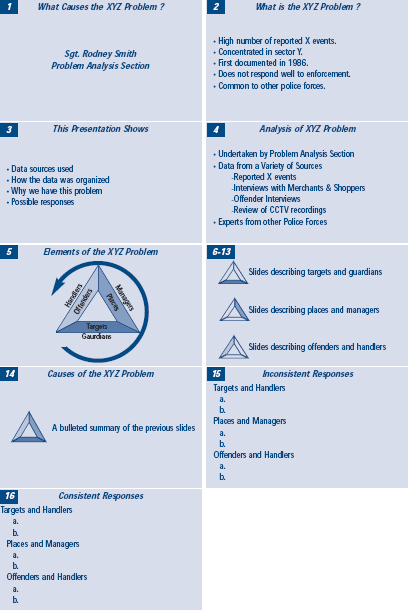
Center for Problem-Oriented Policing
Step 58: Organize powerful presentations
A presentation should begin with a basic question, use a framework to move through a description of findings, and end with a set of specific conclusions (see Step 54). Graphical material should be prepared following the guidance in Steps 55 through 57. In this step we will focus on the story you are telling. In Step 59, we will look at how the presentation should be delivered, including the use of PowerPoint.
The main focus of your presentation should be to answer specific questions that will aid decision-making, and it should consist of the following:
- A set of slides organized around your story.
- A graphical motif or outline slide to keep your audience focused on the story.
The slides illustrates a presentation of analysis findings. The presenter, Sergeant Smith, has two goals. The first is to answer the question, "What causes this problem?" The second is to open up a discussion of possible responses. The title slide asks the question (and introduces the presenter). This and slides 2 to 4 constitute the introduction. Slide 2 reinforces a set of already agreed points that serve as a foundation for what follows. Slide 3 outlines the presentation and slide 4 summarizes data collection.
The framework is presented in the fifth slide. Sgt. Smith uses the crime triangle. He keys all of the findings that follow to this triangle. (Note that this only works if Smith's audience is already familiar with the triangle. If they are not, then Smith should use a different framework.) To reinforce this message, and to keep the audience from getting lost, Sgt. Smith uses the triangle motif throughout the presentation of findings, with slight but important modifications: the shaded side and the color change as slides move from targets and guardians, to places and managers, and to offenders and handlers. The circular arrow in slide 5 indicates the counterclockwise order in which Sgt. Smith will present the findings. So in this slide, Sgt. Smith has simultaneously described his framework and provided an outline of the main findings.
Slides 6 to 13 present tables, figures and maps that tell the audience about the elements described in the framework. A bar chart might show the actions used to protect targets. A location map might show the places where the problem is particularly prevalent in contrast to where it is absent. Photos might show particularly important features of these sites. A table might show the frequency with which offenders are arrested.
Slide 14 summarizes these findings. Here, the triangle shows all sides shaded, reinforcing the point that the separate findings are part of a larger whole. The final slides list response options that are consistent with the findings and options that are inconsistent. Though Sgt. Smith gives his expert opinion, these final slides are meant to open up a discussion that is informed by the earlier findings. It is the decision-makers who have the final say in this matter.
It is important to keep your audience focused on the larger story and from getting lost in the details. Two methods for accomplishing this are to use an ongoing motif (like the triangle in the figure) or a highlighted outline slide. When using an outline slide, the outline is shown before each topic. The topic to be presented is highlighted on the outline and the other topics are dimmed. In Sgt. Smith's presentation, the outline slide would be shown four times, before each of the main topics.
Handouts of your slides are useful, but there are some limitations. You can make last-minute changes in the slides more easily than in the handouts. If you expect major last-minute changes, handouts may not correspond to the images. Color slides are often not legible when photocopied in black and white. If you are using PowerPoint, then the "pure black and white" option in the "Print" menu will temporarily convert your color slides to black and white for printing.
Most decision-makers are not as interested as you are in the methods you used to analyze your problem. Therefore, do not spend a great deal of time describing your methods, unless this is the objective of the presentation. Rather, summarize the main elements (see slide 4). You can prepare separate slides about methods, held in reserve, should audience members have questions about your methods.

Read More
- RAND, Guidelines for Preparing Briefings, Santa Monica, CA, 1996, http://www.rand.org/publications/CP/CP269/CP269.pdf
- Ratcliffe, Jerry H, (2004) "Jerry's Top Ten Crime Mapping Tips." http://www.jratcliffe.net/papers/Jerry%27s%20top%20ten %20mapping%20tips.pdf